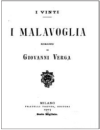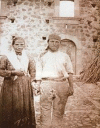One hundred years after the death of the writer and novelist Giovanni Verga (1922) and his relationship with public health: a glimpse of the past in the era of the SARS-CoV-2 (COVID-19) pandemic
- PMID: 37293453
- PMCID: PMC10246619
- DOI: 10.15167/2421-4248/jpmh2023.64.1.2839
One hundred years after the death of the writer and novelist Giovanni Verga (1922) and his relationship with public health: a glimpse of the past in the era of the SARS-CoV-2 (COVID-19) pandemic
Abstract
Background: In 1922 the famous Italian novelist Giovanni Verga died in Catania (Italy). In Verga's works there are many suggestions to the world of medicine, in particular the diseases described in the poor society of southern Italy of that time. One of the most common diseases described by Verga was cholera.
Methods: The authors researched and reviewed Verga's works, detecting references to public health. These are topical issues in the current period of the COVID pandemic. In Verga's works the theme of hygiene, epidemiology, and infectious diseases occur. There are many hints related to medicine, especially as far as the typical diseases of poor society and the difficult social environments of the time are concerned. One of the most common diseases described by Verga was cholera but also malaria and tuberculosis occur.
Results: It was estimated that 69,000 people died of cholera in Sicily, of whom 24,000 in Palermo. The public health situation in Italy was difficult. Verga denounces people's ignorance and the survival of past beliefs.
Conclusion: Verga describes a culturally and economically humble society, in a region characterized by large class gaps. It draws a difficult picture of the public health situation in the second half of the 19th Century and people's daily lives. The authors believe that today it is important that the centenary of Verga's death be an opportunity to read his works, also from a medical historical point of view.
Keywords: Epidemiology; Giovanni Verga; History of public health; Hygiene and literature; Medical humanities; Social status and class; XIX Century.
©2023 Pacini Editore SRL, Pisa, Italy.
Conflict of interest statement
Each author declares that they have no commercial associations (e.g. consultancies, stock ownership, equity interest, patent/licensing arrangement etc.) that might pose a conflict of interest in connection with the submitted article.
Figures




References
-
- Baldini A. The liberal imagination of Giovanni Verga: verismo as moral realism, The Italianist 2017;37:348-68. https://doi.org/10.1080/02614340.2017.1409313 10.1080/02614340.2017.1409313 - DOI
-
- Fochi Caturegli A. Traduttori del Verga in lingua inglese. Italianistica 1982;1:35-47. Available at: http://www.jstor.org/stable/23928640 (Accessed on: January 9, 2023).
-
- Verga G. Masterpieces include the short stories of: Vita dei campi (1880) – “Life in the Fields”; Novelle rusticane (1883) – Little Novels of Sicily; the great novels I Malavoglia (1881); Mastro don Gesualdo (1889); Cavalleria rusticana (1884), a comedy that was set to music by Pietro Mascagni (1890).
-
- Verga G. The house by the Medlar Tree. CreateSpace Independent Publishing Platform; 2016. [Translated by Mary A. Craig].
-
- Verga G. Master Don Gesualdo. London: Osgood & McIlvaine; 1893. [Translated by Mary A. Craig].
MeSH terms
LinkOut - more resources
Full Text Sources
Medical
Miscellaneous
